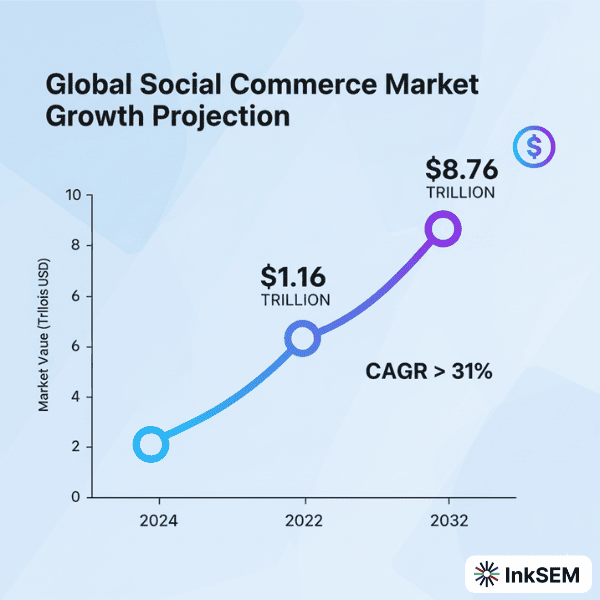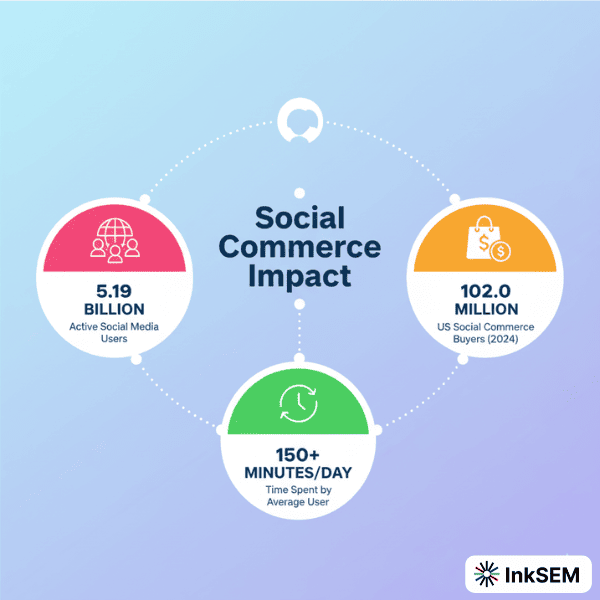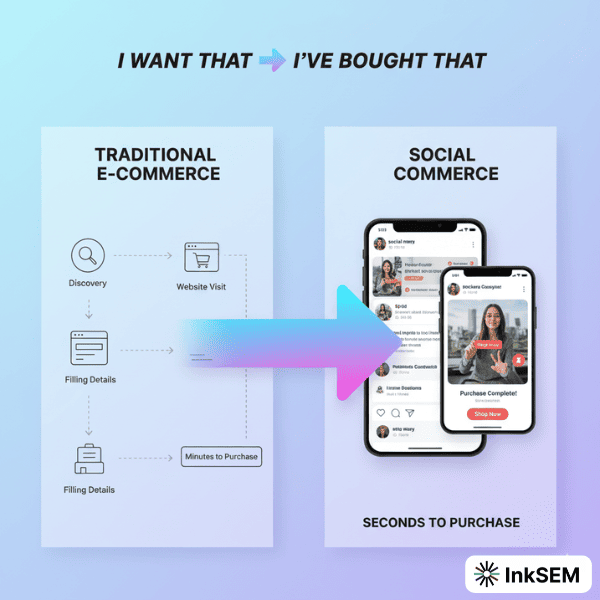The Ultimate Social Commerce Guide: How to Sell Directly on Social Media Platforms?

Traditional e-commerce is failing. The linear path from ad to website to checkout is broken. Your customers are already on social media, but you force them to leave the platform to make a purchase. This friction is costing you sales.
Social commerce is the solution. It is no longer an option; it is a mandatory shift in retail. This strategy transforms social platforms from simple discovery tools into dynamic, high-conversion marketplaces. The purchase must happen at the point of inspiration.
This guide is your blueprint for implementation. We will cover the essential platforms, conversion tactics, and the AI tools you must leverage to win.
Why Social Commerce Is Non-Negotiable?

The data is not a suggestion; it is a directive. As of 2024, the global social commerce market is valued at approximately $1.16 trillion and is projected to explode to $8.76 trillion by 2032, driven by a CAGR of over 31%.
Your audience lives on these platforms:
- Active Users: There are 5.19 billion active social media users worldwide as of mid-2024.
- Time Spent: The average user spends around 150+ minutes on social media every single day.
- Purchase Behavior: In the US alone, 102.0 million people will make a purchase via social commerce in 2024. That number is projected to climb to 118.9 million by 2028.

Social commerce closes the gap between “I want that” and “I’ve bought that” from minutes to seconds. It embeds your checkout directly into the user’s entertainment feed. This combination of discovery, social proof, and in-app convenience is irresistible to the modern consumer.
Selecting the Right Social Platform for Best Conversions
You must not be on every platform. You must be on the right platforms for your audience and product. Your resource allocation must be strategic.
It remains the all-in-one ecosystem. Facebook Shops and Marketplace provide a comprehensive infrastructure for diverse product catalogs. Its mature ad-targeting capabilities allow for granular audience segmentation.
Best for: Reaching diverse demographics and building a comprehensive, integrated shop that syncs with Instagram.
This is the visual showroom. Instagram is built for aesthetic-driven discovery. Features like Shoppable Posts, Product Tags, and Shop tabs transform beautiful imagery into direct sales opportunities.
Best for: Visually-driven brands (fashion, beauty, home decor) that thrive on high-quality, aspirational content.
TikTok Shop
This is the viral sales engine. With the #TikTokMadeMeBuyIt hashtag earning over 80 billion views, this platform proves that entertainment drives transactions. TikTok Shop integrates purchasing directly into in-feed videos, livestreams, and profile tabs.
Best for: Brands targeting Gen Z and Millennials who can create authentic, fast-paced, and entertaining video content.
This is the planning-to-purchase funnel. Users come to Pinterest with high purchase intent. Over 50% of users see Pinterest as a place to shop. The platform reports a 50% increase in user interaction with shoppable pins.
Best for: Home, fashion, food, and DIY brands where users are actively planning future projects and purchases.
YouTube Shopping
This is the expert-led marketplace. YouTube has evolved beyond simple ad revenue, allowing creators to tag products directly in videos, Shorts, and livestreams. This leverages the trust creators have built with their audiences.
Best for: Brands that benefit from long-form tutorials, in-depth reviews, and expert-led demonstrations (e.g., tech, cosmetics, tools).
WhatsApp Business
This is the conversational checkout. Using the Catalog feature, you can showcase products and complete sales within a direct message. This is a high-touch, trust-building approach to commerce.
Best for: High-consideration products or B2B marketing where personalized customer service is critical.
Building Your Digital Storefront: A Platform-Specific Blueprint

A successful storefront is more than just a product feed. It requires platform-native execution.
- Facebook and Instagram Shops: This is your central hub. You must set up a Commerce Account via Commerce Manager and link a product catalog. Success here demands high-quality, contextual lifestyle imagery, not sterile product-on-white backgrounds. You should also leverage product collections to curate your storefront and use livestream shopping to demo products and answer questions in real-time.
- TikTok Shop: This is an entertainment-first platform. Your content must feel native and entertaining, not like a traditional ad. You must register through the TikTok Seller Center. The most effective strategy is to leverage the TikTok affiliate program to have creators sell your products for you.
- Pinterest: Your goal here is inspiration-led conversion. You must have a Pinterest Business account and connect your product catalog to automatically create “Product Pins.” These pins display real-time pricing and availability. Use the new Collage feature to create shoppable mood boards that link directly to your products.
- YouTube Shopping: Success here depends on content value. You must meet the YouTube Partner Program eligibility requirements. Your strategy should be to integrate products naturally into helpful content. A “Top 5 Gadgets” video or a “Makeup Tutorial” that tags the exact products used is the correct approach.
- WhatsApp Catalog: This is about direct, personal selling. You must build your catalog within the WhatsApp Business app. Use “Collections” to organize products (e.g., “New Arrivals,” “Best Sellers”) and use the Shopping Button to make your catalog instantly accessible to customers in the chat.
Integrating AI in Your Social Commerce Strategy
Artificial intelligence is an essential toolkit for scaling your social commerce operations, and here’s how you can use it.
Super Personalization
This is the core of modern social commerce. Analyzing the browsing history, past purchases, and real-time engagement to deliver hyper-personalized product recommendations. These systems anticipate customer needs before they are even expressed. For example, Swarovski reported that its AI-driven recommendations account for 10% of its total website sales.
AI Chatbots as Sales Assistants
Stop thinking of chatbots as simple FAQ bots. They are now virtual sales assistants. On platforms like Messenger and WhatsApp, they guide customers, answer complex product questions, and facilitate purchases 24/7.
AI-Powered Live Shopping
This is where engagement meets conversion. Brands using livestream selling see conversion rates up to 10 times higher than conventional e-commerce. AI supercharges this by automatically displaying product tags the moment an item is mentioned and by analyzing audience sentiment in real-time to help hosts pivot their strategy.
Generative & Visual AI
This is your new content engine. Generative AI can create unique product descriptions, social media captions, and even entire product images from simple text prompts. This democratizes high-end content creation, allowing you to produce visuals without costly photoshoots. Visual AI, like Pinterest’s Lens, allows users to search with their camera, turning real-world inspiration into a direct purchase opportunity.
Conversion Optimization in Social Commerce
A presence is useless without sales. You must optimize every element of your social shop for conversion.
- Leverage Social Proof (UGC): This is non-negotiable. Nine out of ten consumers read reviews before buying. You must actively encourage and feature User-Generated Content (UGC). Tag customers who post photos with your products. Display reviews and ratings prominently.
- Write Persuasive, Data-Rich Copy: Vague product descriptions kill conversions. Your copy must provide all essential data (size, material, specifications) while simultaneously selling the outcome (how the product improves the customer’s life).
- Prioritize Video Content: Static images are not enough. You must show your products in action. How-to videos, before-and-after transformations, and unboxing videos build trust and demonstrate value far more effectively than a simple photo.
- Streamline Your Content Creation and Approval: Persuasive copy, engaging videos, and shoppable images require collaboration between marketers, designers, and e-commerce managers. This workflow is a major conversion bottleneck. Implementing a dedicated social media collaboration workflow is critical. Platforms like Planable provide a central hub where your team can create, preview, and approve all social commerce content.
- Implement Aggressive Remarketing: A customer who viewed a product or abandoned a cart is a high-intent lead. You must use platform tools like Facebook’s Custom Audiences to build targeted remarketing campaigns that bring those users back to complete their purchase.
- Master Mobile Optimization: This is not a suggestion; it is a requirement. Your checkout process must be flawless on a smartphone, tablet, and whatever device your users are on. It must be fast, simple, and require the absolute minimum number of taps.
What to Prepare for Now
The pace of change is accelerating. You must prepare for these trends today.
- Augmented Reality (AR) Shopping: This is moving from novelty to necessity. By 2025, nearly 75% of smartphone users will be frequent AR users. You need a plan for “try-before-you-buy” AR filters for cosmetics, apparel, and furniture.
- Voice Commerce: Your customers will soon ask their phones to buy your product. Your e-commerce strategy must be optimized for conversational voice queries.
- Hyper-Personalization: Future AI will move from predictive to prescriptive, guiding users to products they don’t even know they need yet.
- Unified Commerce: Your social shop, website, and physical store must operate as one entity. You need a 360-degree customer view to provide a seamless experience, no matter where the customer interacts with your brand.
Also Read: Retail Digital Signage Strategies for Boosting Sales
Conclusion
The social commerce revolution is not coming; it is here. The platforms are evolving, AI is accelerating the pace, and your competitors are already implementing these strategies. The future of retail is social, seamless, and intelligent. You must adapt, and you must start now.
